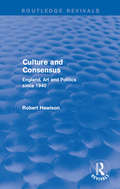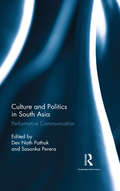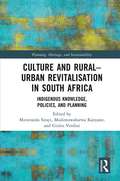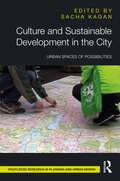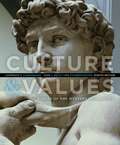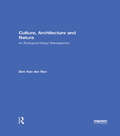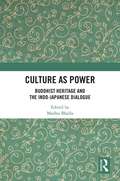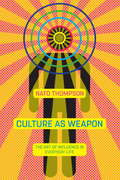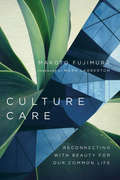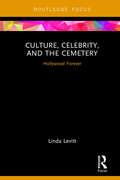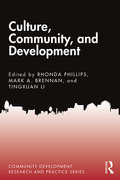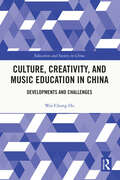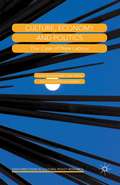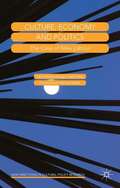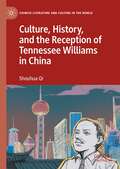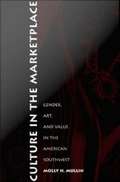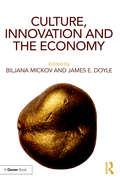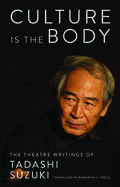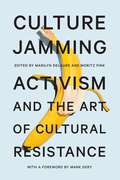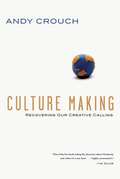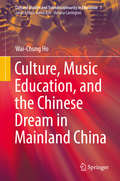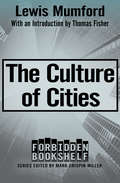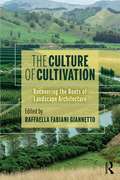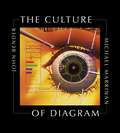- Table View
- List View
Culture and Consensus: England, Art and Politics since 1940 (Routledge Revivals)
by Robert HewisonCulture and Consensus, first published in 1995 and a revised edition in 1997, explores the history of the relationship between politics and the arts in Britain since 1940, and shows how the search for a secure sense of English identity has been reflected in official and unofficial attitudes to the arts, architecture, landscape and other emblems of national significance. Illustrating his argument with a series of detailed case histories, Robert Hewison analyses how Britain’s cultural life has reached its present enfeebled condition and suggests a way forward. This book will be of interest to students of art and cultural studies.
Culture and Politics in South Asia: Performative Communication
by Dev Nath Pathak Sasanka PereraThis volume looks at the politics of communication and culture in contemporary South Asia. It explores languages, signs and symbols reflective of current mythologies that underpin instances of performance in present-day India and its neighbouring countries. From gender performances and stage depictions to protest movements, folk songs to cinematic reconstructions and elections to war-torn regions, the chapters in the book bring the multiple voices embedded within the grand theatre of popular performance and the cultural landscape of the region to the fore. Breaking new ground, this work will prove useful to students and researchers in sociology and social anthropology, art and performance studies, political studies and international relations, communication and media studies and culture studies.
Culture and Rural–Urban Revitalisation in South Africa: Indigenous Knowledge, Policies, and Planning (Planning, Heritage and Sustainability)
by Mziwoxolo SirayiThis book captures ground-breaking attempts to utilise culture in territorial development and regeneration processes in the context of South Africa and our 'new normal' brought by COVID-19, the fourth industrial revolution, and climate change the world over. The importance of culture in rural-urban revitalisation has been underestimated in South Africa and the African continent at large. Despite some cultural initiatives that are still at developmental stages in big cities, such as Johannesburg, eThekwini and Cape Town, there is concern about the absence of sustainable policies and plans to support culture, creativity, and indigenous knowledge at national and municipal levels. Showcasing alternative strategies for making culture central to development, this book discusses opportunities to shift culture and indigenous knowledge from the peripheries and place them at the epicentre of sustainable development and the mainstream of cultural planning, which can then be applied in the contexts of Africa and the Global South. Governmental institutions, research councils, civil society organisations, private sector, and higher education institutions come together in a joint effort to explain the nexus between culture, economic development, rural-urban linkages, grassroots and technological innovations. Culture and Rural-Urban Revitalization in South Africa is an ideal read for those interested in rural and urban planning, cultural policy, indigenous knowledge and smart rural village model.
Culture and Sustainable Development in the City: Urban Spaces of Possibilities
by Sacha KaganThis book exposes the potential to advance a cultural approach to sustainable urban development. It explores urban "spaces of possibilities" and links them to the seized or missed opportunities for innovative forms of transversal partnerships throughout the city and of culturally sensitive urban policies. The call for sustainability brings with it challenges for which, in view of the urgency of social transformation, institutional innovations are necessary. Sustainable urban development will only succeed through creative impulses, experiments, trying out innovative ideas, and making alternatives visible, in particular through locally rooted urban initiatives, artistic actions, and social movements. Discussing many concrete examples from several years of empirical research in the cities of Hanover and Hamburg (Germany), Baltimore and Chicago (USA), Bangalore (India), St. Petersburg (Russia), Singapore, and Vancouver (Canada), the book connects urban spaces and their actors; looks at their guiding principles, strategies, and concrete practices; and identifies new levers, networks, and alliances. Readers will find in this book not only inspiring examples of culture in everyday life in the city but also explanations about the qualities that make local cultural initiatives especially full of potentials, and how they may translate into city-wide changes, engaging with the whole City as Space of Possibilities. The book will interest researchers and advanced students in the interdisciplinary fields of urban studies, sustainability science/sustainability research, cultural sciences, urban sociology, and sociology of the arts/cultural sociology; and those interested in the transdisciplinary collaborations between the arts, academia, and civil society.
Culture and Sustainable Development in the City: Urban Spaces of Possibilities (Routledge Research in Planning and Urban Design)
by Sacha KaganThis book exposes the potential to advance a cultural approach to sustainable urban development. It explores urban "spaces of possibilities" and links them to the seized or missed opportunities for innovative forms of transversal partnerships throughout the city and of culturally sensitive urban policies.The call for sustainability brings with it challenges for which, in view of the urgency of social transformation, institutional innovations are necessary. Sustainable urban development will only succeed through creative impulses, experiments, trying out innovative ideas, and making alternatives visible, in particular through locally rooted urban initiatives, artistic actions, and social movements. Discussing many concrete examples from several years of empirical research in the cities of Hanover and Hamburg (Germany), Baltimore and Chicago (USA), Bangalore (India), St. Petersburg (Russia), Singapore, and Vancouver (Canada), the book connects urban spaces and their actors; looks at their guiding principles, strategies, and concrete practices; and identifies new levers, networks, and alliances. Readers will find in this book not only inspiring examples of culture in everyday life in the city but also explanations about the qualities that make local cultural initiatives especially full of potentials, and how they may translate into city-wide changes, engaging with the whole City as Space of Possibilities.The book will interest researchers and advanced students in the interdisciplinary fields of urban studies, sustainability science/sustainability research, cultural sciences, urban sociology, and sociology of the arts/cultural sociology; and those interested in the transdisciplinary collaborations between the arts, academia, and civil society.
Culture and Values: A Survey of the Humanities (8th Edition)
by Lawrence S. Cunningham John J. Reich Lois Fichner-RathusCULTURE AND VALUES: A SURVEY OF THE WESTERN HUMANITIES takes you on a fascinating tour of some of the world's most significant examples of art, music, philosophy, and literature, from the beginnings of civilization to today. New features in the eighth edition are designed to make it easy for you to understand the influence of historical events and values on the works produced by each culture--guided discussions of all of the readings, chapter previews, timelines, "Compare and Contrast" sections, "Big Picture" reviews at the end of each chapter, and high-quality images with clear captions.
Culture, Architecture and Nature: An Ecological Design Retrospective
by Sim Van der RynGathering his most compelling essays and addresses from the last fifty years in one accessible volume, this book looks at the pioneering ideas that underpin Sim Van der Ryn’s ecological design philosophy. It offers a unique decade-by-decade retrospective of the key issues in environmental design, beginning with the most recent years and looking back to the 1960s. With an introductory chapter and further recommended reading for each decade, this book is key reading for any architect or designer practising today, and students will find a wealth of knowledge with which to support their studies. The author’s beautiful illustrations, painted in a corresponding timescale to the chapters, offer further insight into the way he understands the challenges of humanity’s stewardship of our planet.
Culture as Power: Buddhist Heritage and the Indo-Japanese Dialogue
by Madhu BhallaThis book presents new studies on intellectual and cultural interactions in the context of Buddhist heritage and Indo-Japanese dialogue in the late 19th and early 20th centuries on art, religion, and cultural politics. By revisiting Buddhist connections between India and Japan, it examines the pathways of communication on common aesthetic and religious heritage that emerged in the backdrop of colonial experiences and the rise of Asian nationalisms. The volume discusses themes such as Asian arts and crafts under colonialism, formation of East Asian art collections, development of Buddhist art history in Japan, Japanese encounters with Ajanta, India in the history of the Shinto tradition, Japan in India’s xenology, and Buddhism and world peace, and suggests paradigms of reconnecting cultural heritage within a global platform. With essays from experts across the world, this book will be an essential read for scholars and researchers of history, art history, ancient Indian history, colonial history, heritage and cultural studies, South Asian and East Asian history, visual and media studies, Asian studies, international relations and foreign policy, and the history of globalization.
Culture as Weapon: The Art of Influence in Everyday Life
by Nato ThompsonOne of the country's leading activist curators explores how corporations and governments have used art and culture to mystify and manipulate us.The production of culture was once the domain of artists, but beginning in the early 1900s, the emerging fields of public relations, advertising and marketing transformed the way the powerful communicate with the rest of us. A century later, the tools are more sophisticated than ever, the onslaught more relentless. In Culture as Weapon, acclaimed curator and critic Nato Thompson reveals how institutions use art and culture to ensure profits and constrain dissent--and shows us that there are alternatives. An eye-opening account of the way advertising, media, and politics work today, Culture as Weapon offers a radically new way of looking at our world.
Culture Care: Reconnecting with Beauty for Our Common Life
by Makoto Fujimura15th Annual Outreach Magazine Resource of the Year - Culture Christianity Today's 2018 Book of the Year Award of Merit - Culture and the Arts "Culture is not a territory to be won or lost but a resource we are called to steward with care. Culture is a garden to be cultivated." Many bemoan the decay of culture. But we all have a responsibility to care for culture, to nurture it in ways that help people thrive. In Culture Care artist Makoto Fujimura issues a call to cultural stewardship, in which we become generative and feed our culture's soul with beauty, creativity, and generosity. We serve others as cultural custodians of the future. This is a book for artists, but artists come in many forms. Anyone with a calling to create—from visual artists, musicians, writers, and actors to entrepreneurs, pastors, and business professionals—will resonate with its message. This book is for anyone with a desire or an artistic gift to reach across boundaries with understanding, reconciliation, and healing. It is a book for anyone with a passion for the arts, for supporters of the arts, and for "creative catalysts" who understand how much the culture we all share affects human thriving today and shapes the generations to come. Culture Care includes a study guide for individual reflection or group discussion.
Culture, Celebrity, and the Cemetery: Hollywood Forever (Heritage, Tourism, and Community)
by Linda LevittMonuments and memorials commemorating the dead and past events around the world have recently gained importance, not least because we are living in an era in which many are driven to record and archive the events of their lives. Cemeteries, in particular, are increasingly viewed as places associated with popular culture and cultural memory, with many now being considered as heritage tourism sites. Culture, Celebrity, and the Cemetery analyses the famous Hollywood Forever Cemetery in Los Angeles, USA, examining how the cemetery presents itself as an attraction, whilst also safeguarding and promoting cultural heritage. Focusing on an analysis of the articulation and performance of commemoration, Levitt examines how the cemetery leverages its rich resources to draw visitors and the diverse ways in which visitors interact with the cemetery, considering the influence of celebrity culture, fandoms, and cinema culture. Combining ethnographic research with cultural analysis, the book situates Hollywood Forever in the context of cemetery development in the United States and argues that touristic visits to cemeteries more generally have become similar to visits to more traditional memorials. Providing more than just a critical analysis of this fascinating cemetery as a landscape of famous death, Levitt coherently weaves the theme of cultural memory and meaning-making throughout every chapter. Offering the first book-length study of the cultural impact of Hollywood Forever in particular, and the cemetery as public heritage space in general, Culture, Celebrity, and the Cemetery will be of interest to scholars and students of heritage studies and tourism around the world.
Culture, Community, and Development (Community Development Research and Practice Series)
by Rhonda Phillips Mark A. BrennanCulture is a living thing. In social settings, it is often used to represent entire ways of life, including rules, values, and expected behavior. Varying from nation to nation, neighborhood to neighborhood and beyond, even in the smallest localities, culture is a motivating factor in the creation of social identity and serves as a basis for creating cohesion and solidarity. This book explores the intersection of culture and community as a basis for locally and regionally based development by focusing on three core bodies of literature: theory, research, and practice. The first section, theory, uncovers some of the more relevant historical arguments, as well as more contemporary examinations. Continuing, the research section sheds light on some of the key concepts, variables, and relationships present in the limited study of culture in community development. Finally, the practice section brings together research and theory into applied examples from on the ground efforts. During a time where the interest to retain the uniqueness of local life, traditions, and culture is significantly increasing in community-based development, the authors offer a global exploration of the impacts of culturally based development with comparative analysis in countries such as Korea, Ireland, and the United States. A must-read for community development planners, policymakers, students, and researchers.
Culture, Creativity, and Music Education in China: Developments and Challenges (Education and Society in China)
by Wai-Chung HoHo's book explores music education in China, and how creativity, education reforms, and social transformation can be enabled through music. The essential elements of music discussed include perception and creativity, sources and stimulation, and the integration of musical creativity in diverse cultures and participation. It focuses on three Chinese cities; Changsha and Hong Kong Special Administrative Region of China, which have creative industries, and Shijiazhuang, which has cultural industries. Readers will gain insights into the introduction of creativity into the Chinese education system through music, particularly during the pandemic. The author analyses official documents, selected music textbooks adopted by schools, questionnaire surveys, and in-depth interviews with both students and teachers. These interviews reveal the underbelly of the dilemmas of introducing creativity into schools through music education. The volume will be of interest to those keen to increase creativity in teaching through music, and researchers in the fields of creativity and music education. It will also interest students undertaking Chinese, teacher education, or music.
Culture, Economy and Politics: The Case of New Labour (New Directions in Cultural Policy Research)
by David Hesmondhalgh Kate Oakley David Lee Melissa NisbettThis book focuses on cultural policy in the UK between 1997 and 2010 under the Labour party (or 'New Labour', as it was temporarily rebranded). It is based on interviews with major figures and examines a range of policy areas including the arts, creative industries, copyright, film policy, heritage, urban regeneration and regional policy.
Culture, Economy and Politics: The Case Of New Labour (New Directions In Cultural Policy Research Ser.)
by David Lee David Hesmondhalgh Kate Oakley Melissa NisbettThis book focuses on cultural policy in the UK between 1997 and 2010 under the Labour party (or 'New Labour', as it was temporarily rebranded). It is based on interviews with major figures and examines a range of policy areas including the arts, creative industries, copyright, film policy, heritage, urban regeneration and regional policy.
Culture, History, and the Reception of Tennessee Williams in China (Chinese Literature and Culture in the World)
by Shouhua QiThis book is the first comprehensive study of the reception of Tennessee Williams in China, from rejection and/or misgivings to cautious curiosity and to full-throated acceptance, in the context of profound changes in China’s socioeconomic and cultural life and mores since the end of the Cultural Revolution. It fills a conspicuous gap in scholarship in the reception of one of the greatest American playwrights and joins book-length studies of Chinese reception of Shakespeare, Ibsen, O’Neill, Brecht, and other important Western playwrights whose works have been eagerly embraced and appropriated and have had catalytic impact on modern Chinese cultural life.
Culture in the Marketplace: Gender, Art, and Value in the American Southwest
by Molly MullinIn the early twentieth century, a group of elite East coast women turned to the American Southwest in search of an alternative to European-derived concepts of culture. In Culture in the Marketplace Molly H. Mullin provides a detailed narrative of the growing influence that this network of women had on the Native American art market--as well as the influence these activities had on them--in order to investigate the social construction of value and the history of American concepts of culture. Drawing on fiction, memoirs, journalistic accounts, and extensive interviews with artists, collectors, and dealers, Mullin shows how anthropological notions of culture were used to valorize Indian art and create a Southwest Indian art market. By turning their attention to Indian affairs and art in Santa Fe, New Mexico, she argues, these women escaped the gender restrictions of their eastern communities and found ways of bridging public and private spheres of influence. Tourism, in turn, became a means of furthering this cultural colonization. Mullin traces the development of aesthetic worth as it was influenced not only by politics and profit but also by gender, class, and regional identities, revealing how notions of "culture" and "authenticity" are fundamentally social ones. She also shows how many of the institutions that the early patrons helped to establish continue to play an important role in the contemporary market for American Indian art. This book will appeal to audiences in cultural anthropology, art history, American studies, women's studies, and cultural history.
Culture, Innovation and the Economy
by Biljana Mickov James E. DoyleThis is a handbook for the cultural entrepreneur, offering some of the best examples on practice, franchises, research, innovation and business opportunities in the cultural sector. The key theme is the contribution and possibilities of the cultural economy as a business, with a strong supporting subtext on innovative practice. The book illustrates the theme by providing multiple practice-based and empirical examples from an international panel of experts. Each contribution provides an accessible and easily accessed bank of knowledge on which existing practice can be grown and new projects undertaken. It provides an eclectic mix of possibilities that reinforce and underscore the full innovative and complex potential of the cultural economy. Topics include a review of the global and regional economic benefits of the cultural economy, evidence-based analysis of the culture industries, and an outline of the top ten cultural opportunities for business. This collection transcends the space between theory and practice to combine culture and innovation and understand their importance to a wider economy. This is essential reading for researchers and practitioners interested in entrepreneurship, non-profit management, art and visual culture, and public finance.
Culture is the Body
by Tadashi Suzuki Kameron Steele"Mr. Suzuki's art seeks to reach audiences not through the intellect but through the senses and instincts."--New York Times"In my opinion, a 'cultured' society is one where the perceptive and expressive abilities of the human body are used to the full; where they provide the basic means of communication."--Tadashi SuzukiRenowned for his actor training methods, Tadashi Suzuki provides a thorough and accessible formulation of his ideas and beliefs in this new edition of his theater writings. One of the world's most revered theater directors, Suzuki is also a seminal thinker and practitioner whose work has had a profound influence on theater worldwide. This landmark collection provides a useful, provocative look at his philosophical and practical approaches to the stage. Culture is the Body is a complete revision of Suzuki's influential book The Way of Acting, featuring new essays and in a revised translation by Kameron Steele, a longtime collaborator of Suzuki's.Legendary theater director Tadashi Suzuki explains his revered approach in this new edition of his writings.Tadashi Suzuki is the founder and director of the Suzuki Company of Toga (SCOT), the organizer of Japan's first international theater festival (Toga Festival), and the creator of the Suzuki Method of Actor Training. Suzuki has articulated his theories in a number of books. He has taught his system of actor training in schools and theaters throughout the world. Besides productions with his own company, he has directed several international collaborations.
Culture Jamming: Activism and the Art of Cultural Resistance
by Mark Dery Marilyn Delaure Moritz FinkCoined in the 1980s, “culture jamming” refers to an array of tactics deployed by activists to critique, subvert, and otherwise “jam” the workings of consumer culture. Ranging from media hoaxes and advertising parodies to flash mobs and street art, these actions seek to interrupt the flow of dominant, capitalistic messages that permeate our daily lives. Employed by Occupy Wall Street protesters and the Russian feminist punk band Pussy Riot alike, culture jamming scrambles the signal, injects the unexpected, and spurs audiences to think critically and challenge the status quo. The essays, interviews, and creative work assembled in this unique volume explore the shifting contours of culture jamming by plumbing its history, mapping its transformations, testing its force, and assessing its efficacy. Revealing how culture jamming is at once playful and politically transgressive, this accessible collection explores the degree to which culture jamming has fulfilled its revolutionary aims. Featuring original essays from prominent media scholars discussing Banksy and Shepard Fairey, foundational texts such as Mark Dery’s culture jamming manifesto, and artwork by and interviews with noteworthy culture jammers including the Guerrilla Girls, The Yes Men, and Reverend Billy, Culture Jamming makes a crucial contribution to our understanding of creative resistance and participatory culture.
Culture Making: Recovering Our Creative Calling
by Andy CrouchIt is not enough to condemn culture. Nor is it sufficient merely to critique culture or to copy culture. Most of the time, we just consume culture. But the only way to change culture is to create culture. In his new book Andy Crouch unleashes a stirring manifesto calling Christians to be culture makers. For too long Christians have had an insufficient view of culture and have waged misguided "culture wars." But we must reclaim the cultural mandate to be the creative cultivators that God designed us to be. A model of his premise, this landmark book is sure to be a rallying cry for a new generation of culturally creative Christians. Discover your calling to become a culture maker! Endorsements "Culture Making is a book that's been needed for decades, but it arrives at just the right moment. People of faith now poised to use their influence have much to contribute to the common good as creators and advocates, not just as critics and judges. But that requires careful thought and clear insight, both of which are abundantly found in this profound and practical book." D. Michael Lindsay, author of Faith in the Halls of Power and assistant professor of sociology, Rice University
Culture, Music Education, and the Chinese Dream in Mainland China (Cultural Studies and Transdisciplinarity in Education #7)
by Wai-Chung HoThis book focuses on the rapidly changing sociology of music as manifested in Chinese society and Chinese education. It examines how social changes and cultural politics affect how music is currently being used in connection with the Chinese dream. While there is a growing trend toward incorporating the Chinese dream into school education and higher education, there has been no scholarly discussion to date. The combination of cultural politics, transformed authority relations, and officially approved songs can provide us with an understanding of the official content on the Chinese dream that is conveyed in today's Chinese society, and how these factors have influenced the renewal of values-based education and practices in school music education in China.
The Culture of Cities (Forbidden Bookshelf #19)
by Mark Crispin Miller Lewis Mumford Thomas FisherA visionary survey of urbanism from the Middle Ages to the late 1930s, with a new introduction by Thomas Fisher Considered among the greatest works of Lewis Mumford--a prolific historian, sociologist, philosopher of technology, and longtime architecture critic for the New Yorker--The Culture of Cities is a call for communal action to "rebuild the urban world on a sounder human foundation." First published in 1938, this radical investigation into the human environment is based on firsthand surveys of North American and European locales, as well as extensive historical and technological research. Mumford takes readers from the compact, worker-friendly streets of medieval hamlets to the symmetrical neoclassical avenues of Renaissance cities. He studies the squalor of nineteenth-century factory towns and speculates on the fate of the booming twentieth-century Megalopolis--whose impossible scale, Mumford believes, can only lead to its collapse into a "Nekropolis," a monstrosity of living death. A civic visionary, Mumford is credited with some of the earliest proposals for ecological urban planning and the appropriate use of technology to create balanced living environments. In the final chapters of The Culture of Cities, he outlines possible paths toward utopian future cities that could be free of the stressors of the Megalopolis, in sync with the rhythms of daily life, powered by clean energy, integrated with agricultural regions, and full of honest and comfortable housing for the working class. The principles set forth by these visions, once applied to Nazi-occupied Europe's razed cities, are still relevant today as technological advances and overpopulation change the nature of urban life.
The Culture of Cultivation: Recovering the Roots of Landscape Architecture
by Raffaella Fabiani GiannettoBy seeking to rediscover the profession's agricultural roots, this volume proposes a 21st-century shift in thinking about landscape architecture that is no longer driven by binary oppositions, such as urban and rural; past and present; aesthetics and ecology; beautiful and productive, but rather prioritizes a holistic and cross-disciplinary framing. The illustrated collection of essays written by academics, researchers and experts in the field seeks to balance and redirect a current approach to landscape architecture that prioritizes a narrow definition of the regional in an effort to tackle questions of continuous urban growth and its impact on the environment. It argues that an emphasis on conurbation, which occurs at the expense of the rural, often ignores the reality that certain cultivation and management practices taking place on land set aside for production can be as harmful to the environment as is unchecked urbanization, contributing to loss of biodiverstiy, soil erosion and climate change. By contrast, the book argues that by expanding the expertise of design professionals to include the productive, food systems, soil conservation and the preservation of cultural landscapes, landscape architects would be better equipped to participate in the stewardship of our planet. Written primarily for landscape practitioners and academics, cultural and environmental historians and conservationists, The Culture of Cultivation will appeal to anyone interested in a thorough rethinking of the role and agency of landscape architecture.
The Culture of Diagram
by John Bender Michael MarrinanThe diagram, write Bender (interdisciplinary studies, Stanford U.) and Marrinan (art history, Stanford U.), "is a proliferation of manifestly selective packets of dissimilar data correlated in an explicitly process-oriented array that has some of the attributes of a representation but is situated in the world like an object." They present here an "archaeology of the diagram" that centers on this understanding of diagram as process. Their discussion ranges across 250 years, from the diagrams of Diderot's Encylopédie to diagrammatic forms of representation in quantum mechanics, and across multiple fields of human endeavor, including mathematics, art, and medicine. Annotation ©2010 Book News, Inc., Portland, OR (booknews.com)
